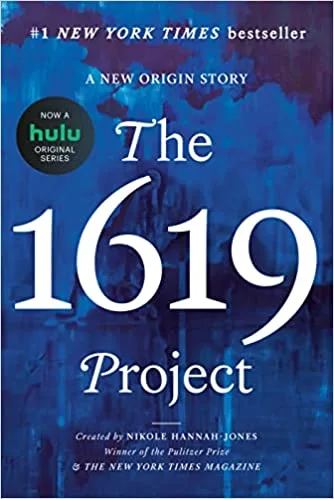“The 1619 Project – A New Origins Story”. Hannah-Jones, Nikole et al, Ed. One World, (Random House), New York, 2021.
The American narrative – and other stories
Most of the world in which there is a decent educational system knows the foundational myths of the United States. Essentially a bunch of oppressed settlers could no longer tolerate the weight of the taxes imposed on them by the King of England, they threw a tea party in Boston as a demonstration against too high taxes – and the revolution was on. It was a revolution for freedom from the tyranny of a governing system that took too much wealth from the colonies when it should remain within the colonies.
 That narrative is more truthful in the latter aspect of the loss of wealth to the King. A more cynical narrative describes the elite of the colonies wanting to guard their own wealth and power and fomented rebellion among the masses – many of whom were not interested in rebelling – in order to capture their own markets, one of the principal factors being ownership of land and the need for an expanding market into the ‘uncivilized’ areas of North America. The leaders of the revolution were all large landowners looking out for their own interests and property.
That narrative is more truthful in the latter aspect of the loss of wealth to the King. A more cynical narrative describes the elite of the colonies wanting to guard their own wealth and power and fomented rebellion among the masses – many of whom were not interested in rebelling – in order to capture their own markets, one of the principal factors being ownership of land and the need for an expanding market into the ‘uncivilized’ areas of North America. The leaders of the revolution were all large landowners looking out for their own interests and property.
That narrative carries even more truth with the recognition of what they considered to be property. Not only were land and ‘things’ property, but people were property as well, and could be bought and sold like any other commodity – except that other commodities did not rebel and fight back from time to time. This third narrative establishes the basis of the common thread of racism, inequality, militarism, inequality, and general violence against persons from the inception of the U.S. to its current condition. The tea party has little consideration in this narrative, which is based more on the value of black slaves and their forced contribution to the economic wealth of the new territories – and as property their potential to be taxed . The original ‘Fathers of Confederation’ were mainly enslavers from the prime slave state of Virginia not from the elites of Boston.
1619 and all that
The roots of the slave holdings of the U.S. revolution is examined in the recent work “The 1619 Project – A New Origins Story” originally published in the New York Times in 2019 and formed into a book in 2021.
It demonstrates how King’s concerns originated with the founding of the country, and as witnessed by current events, still plagues the U.S. system. The U.S. has 40 million and growing living in poverty, ranking 33rd out of 36 OECD countries for inequality [1], has by far the largest military and military budget in the world with over 800 military bases overseas and a similar number domestically , and incarcerates over 3 million of its own people within a largely privatized profit seeking prison system.
1619 marks the year the first slaves were sold into the new British colonies of North America. Marked as property, it was their value as enslaved labour that helped build the wealth of the new colonies, and in this argument, were the principal factor in growing the wealth of the establishment, the enslavers, the large landowners, who harvested the wealth of their slaves. As property, bought and sold, they had absolutely no rights and no way to gain their freedom unless otherwise having it given to them by their owners.
Along with that was the racism rampant within the Christianized world of Europe, stemming in part from the Papal Bull of 1452 (Doctrine of Discovery) declaring all lands open to be christianized and the savages dealt with as best befitting a colonial-settler people – as savages, to be killed or controlled for the ‘discoverers’ benefit. The indigenous people were subject more to genocide; the imported slaves were subject to the laws of property – combined with the self righteous racism of the colonists.
Sugar and Cotton
Sugar was the original wealth creator throughout Latin America and in Louisiana, “None of this growth was possible without trafficking in human lives….The domestic terrorism that ended Reconstruction and destroyed so many black lives was particularly vicious in the sugar region.” But the larger culprit was cotton, the economic power of the southern states from its harvesting, the economic power of they northern states from their manufacturing, and finally the demand for cotton products throughout the British empire and beyond:
“Cotton grown and picked by enslaved workers was the nation’s most valuable export. The combined value of enslaved people exceeded that of all the railroads and factories in the nation….’American slavery is necessarily imprinted on the DNA of American capitalism.’
The importance of this specific kind of property – enslaved people – was both enshrined in the Constitution itself and affirmed by the Supreme Court’s interpretations….After the Civil War, legal provisions originally developed to protect slavery were extended to strengthen corporate interests and prompt laissez-faire capitalism….fundamentally shap[ing]the nation’s economy and the political institutions that governed it.”
In spite of the Civil War, the Emancipation Proclamation, the Civil Rights Act of 1866 (with its declaration of citizenship by birthright), and the series of Civil Rights Acts in the LBJ presidency, black citizens still face the unequal application of laws and regulations governing the U.S. From highways destroying and bisecting black neighbourhoods, criminal laws and resulting court convictions favouring whites, rights of self defense, and poor medical care, the fear of blacks as seen by many current police actions and the presumed guilt in white neighbourhoods of blacks working or passing through – discrimination against blacks has escaped the confines of “We the people” “indivisible with justice and liberty for all.”
Music and Guns
Two items highlight the racism endemic to the U.S. in different ways: the less violent actions concerning black musicians and their music; and the much more violent actions surrounding the Second Amendment for gun rights.
The discussion on music is interesting in showing the strength of black history and its cultural influences on U.S. music and society in general. From an outside perspective there is no music sourced in the U.S. that does not have its roots or is not strongly influenced by black musicians, artists, and producers. Current white pop culture quickly adopts many of the creations and adaptations made by black artists.
While music operates mainly in a non-violent manner, the rules and regulations on gun rights have a dark and violent past within the Constitution and the manner in which it was formed. The right to own guns is accorded to all citizens in the Second Amendment; however the amendment was enacted when neither slaves nor freedmen were considered citizens. Arguments were made and are considered throughout the foundation mythology that its purpose was to prevent an uppity government from over-taxing, over regulating, or creating whatever transgressions an aggrieved people might feel towards their government.
The position present in 1619 argues that the amendment had a larger purpose.
“Though it did not explicitly say so, the Second Amendment was motivated in large part by a need for the new federal government to assure white people in the South that they would be able to defend themselves against Black people.”
Foreign Affairs
The U.S.’ contemporary record domestically and in foreign affairs carries forward their history of violence and racism. The Christian Doctrine of Discovery (see Papal Bull, above) turned most of western Europe’s empires into oppressive regimes creating global empires by militarily dominating other regions of the world, creating major problems in all indigenous areas they tried to control. The British set the stage for future U.S. tendencies, establishing colonial settler colonies around the world, militarily subjugating many other people, and joining freely into the slave trade. The legacy the British left behind in the U.S. is seriously contaminated with the racism and fear of its slavery colonization.
The newly formed U.S. carried the fear, the racism, and the violence forward. Becoming the global hegemon after World War II only seemed to increase their desire for more power and more wealth, from the U.S. dominated global financial institutions to the series of CIA instigated coups beginning with Guatemala and Iran in 1953. Through Haiti, Korea, Vietnam, Brazil, Argentina, Philippines, Cuba, Venezuela and others the U.S. exported its racist fear and violence around the world in order to harvest the wealth for its corporate elite.
After the fall of the Soviet Union, the path was cleared for total dominance, the “full spectrum dominance” advocated by many neocon warhawks in the U.S. establishment. Most of it continued through its violent racism against more of the world, focussed on the Middle East and Africa: Libya, Egypt, Lebanon, Syria, Yemen, Somalia and others have and are suffering the depredations of the U.S. military in the name of “freedom” – freedom for U.S. and global corporations to harvest the land and reduce the people to poor labourers suffering the abuse of a neocolonized people.
Israel is the U.S’ militarized outpost in the Middle East, although at this conjuncture in time it is difficult to tell as to who is directing the relationship – it is a symbiotic match of racial hatred and militarized control of ‘other’ people. The Palestinians suffer from this relationship as do other people in the region either through violent conflict, sanctions, or occupation – or combinations of them all.
China and Russia are now challenging U.S. dominance economically and militarily. The world is now multipolar without clear divisions as to which countries are on one side or another, having to balance the current financial power of the U.S. to its gradual (so far) economic decline. The NATO-Russia war in Ukraine is currently a slow grinding affair threatening the power of the U.S. to maintain its dominance in opposition to the rising power of Russia’s industrialized military warfare along with China’s creation of alternate trading paradigms evading and avoiding as much as possible the use of the US$ for its trade currency.
Unfortunately the U.S. has a history of overseas violence, overtly and covertly. That should not surprise anyone as its entire history is one of violence over land, over people, all to maintain the supremacy of its self appointed exceptionalist mythology. Reading “The 1619 Project – A New Origin Story” provides a set of perspectives that everyone interested in U.S. history should read and absorb for understanding its foundational narrative, and its ongoing actions domestically and abroad.
Jim Miles is a Canadian educator















































